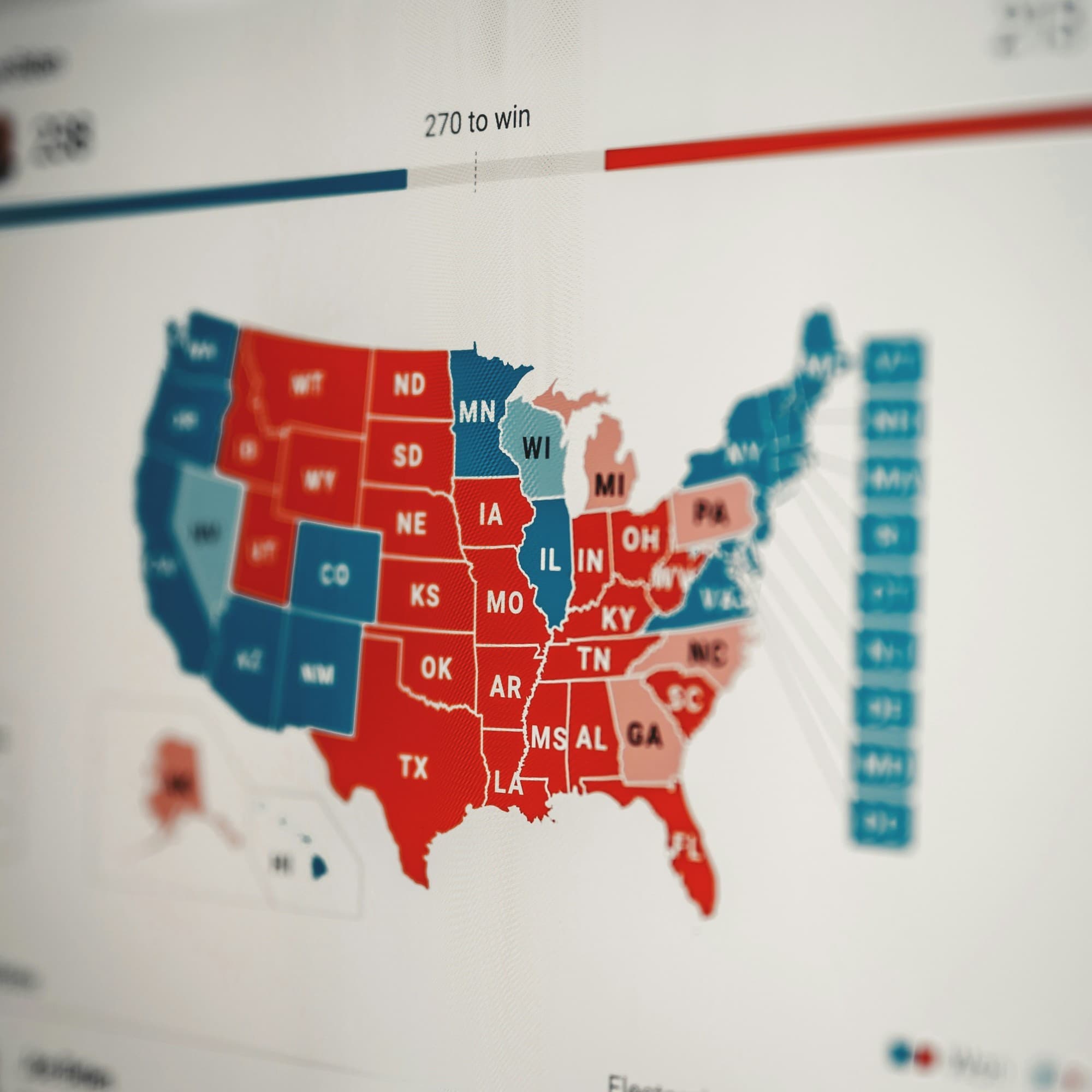
The National Popular Vote Interstate Compact Explained
As a democracy, the outcome of elections in the United States are meant to reflect the will of the people. In many American elections, this means that the popular vote determines the winner. However, it's the Electoral College that determines a presidential election, and swing states have an outsized role in which candidate becomes victorious.
There is an attempt to strengthen democracy that might replace the current electoral system. That effort is known as the National Popular Vote Interstate Compact (NPVIC). For American democracy to strengthen, it might be time to move away from a system that gives outsized importance to certain states and let the national popular vote determine who the next president will be.
The core idea behind the National Popular Vote Interstate Compact is that whichever candidate gets the most votes nationwide should win the presidential election.
What Is the Electoral College?
The Electoral College is a group of electors who are directly responsible for determining the victor in any presidential election. The number of electors who represent the American people are equal to the total number of Congressional senators and representatives from each state.
Once all the campaign activity is done, a candidate must win at least 270 electoral votes to become the president. The final total vote (or popular vote) across the country doesn't influence this decision. That’s why five presidential elections have had a different winner than the candidate who won the national popular vote. Two of these elections happened in 2000 and 2016, with the elections of George W. Bush and Donald Trump.
What Is the National Popular Vote Interstate Compact?
If you're wondering what the National Popular Vote Interstate Compact is to start with, you should know first what it's not.
It's not an attempt to replace the Electoral College directly with something else. That would require a constitutional amendment at the national level. Legislation of that magnitude would have to pass in nearly 40 state governments and by overwhelming majorities in both the Senate and the House of Representatives. The two parties in power, the Democrats and Republicans, are unlikely to agree to such a massive change.
Instead, the idea of the NPVIC is to decide on a state-by-state basis to let the national candidate with the most individual votes win their state’s electoral votes — but only if enough states are participating in the agreement to account for 270 or more electoral votes.
In other words, the agreement would only come into effect if enough states had joined the agreement to determine the outcome of a presidential election.
This proposal works around the high bar set for amending the United States Constitution. The NPVIC’s impact on democracy would not eliminate the Electoral College, but it would mean that a presidential candidate who got the most voters nationally would become the next president.
Since nearly every state currently awards all their electors to the winner of the state’s popular vote, a candidate can win 51% of the vote and carry all the electors from that state. That means the voters who favored the losing party in most areas don't have their voices heard in federal contests, and voter turnout and engagement are lower in many places.
Members of the National Popular Vote Interstate Compact are trying to change that. One tremendous impact of the NPVIC on democracy would be making sure that voters’ voices matter in presidential elections regardless of state borders. The agreement isn't an attempt to eliminate the Electoral College, but to bypass its history of disproportionate representation that makes voters in certain regions matter more than voters in other places.
When the people's will truly determines the outcome of elections, the vote of someone in California would matter just as much as someone in North Dakota. That's not currently the case.
Origins and Evolution of the National Popular Vote Interstate Compact
Maryland was the first state to enact the National Popular Vote Interstate Compact, approving it in 2007. Since then, a total of 17 states and Washington, D.C. have joined the agreement.
Below are the states that have joined the NPVIC as of January 2024, along with the dates that each state joined the agreement:
Maryland (2007)
New Jersey (2008)
Illinois (2008)
Hawaii (2008)
Washington (2009)
Massachusetts (2010)
District of Columbia (2010)
Vermont (2011)
California (2011)
Rhode Island (2013)
New York (2014)
Connecticut (2018)
Delaware (2019)
New Mexico (2019)
Oregon (2019)
Colorado (2020)
Minnesota (2023)
Legislation to join the compact has been introduced in other states as well. The Virginia House of Representatives passed legislation to join the NPVIC in 2020, for example, but the legislation failed to pass through the state senate. Maine and Nevada have also introduced
Member states currently represent a cumulative 205 electoral votes, representing more than 75% of the 270 necessary for the agreement to become binding.
Support for the Popular Vote
How many Americans would like to see the popular vote determine the outcome of presidential elections, as opposed to the Electoral College? Polling from the Pew Research Center reveals that the majority of Americans favor moving away from the Electoral College.
In fact, support for using the popular vote has been growing in recent years. In 2023, 65% of survey respondents said they would like to change the current electoral system so that the candidate with the most votes wins. That number is up from 2020, when 60% of respondents said the same thing.
Younger Americans also seem more likely to support the adoption of the popular vote. In 2023, the age group with the strongest support for its adoption was those ages 18-29. The age group with the weakest support for the popular vote, meanwhile, was those age 65 and above (though even among this group, 58% of respondents said they would prefer to move away from the Electoral College).
Arguments For and Against the National Popular Vote Interstate Compact
There are arguments for and against the National Popular Vote Interstate Compact.
Proponents often argue the same philosophies as those who advocate for direct popular election in saying how the Electoral College is an indirect means of electing a president, and that isn't truly how democracy is supposed to work.
Also, many states that are currently not competitive in federal voting years don't get many campaign visits. That lack of attention can also mean getting less priority from politicians considering running for reelection. Swing states, also known as battleground states, get disproportionately high attention from candidates, and the voters in those places have far more political power than voters in the dozens of areas whose outcomes are largely predetermined for one of the two major parties. The NPVIC could encourage higher voter turnout in so-called flyover countries, where more voting could mean more participation in state and local contests on the same day.
Constitutionality must also be considered when considering arguments for and against the NPVIC. The creators of the Constitution deliberately chose an electoral system as part of the checks and balances that might keep a majority restrained when necessary and protect minority rights. Since the vote of each state matters under the current system, presidential candidates have to offer a broad vision for leading a nation instead of just catering to the biggest population blocs.
Future Prospects and Challenges of the NPVIC
The United States Constitution has a Compact Clause stating that Congressional consent is necessary for an individual state to enter into a compact or agreement with another state. Without the specific consent of Congress, the NPVIC might not be constitutional at all. Whether or not the Compact would survive court challenges is anyone's guess. There are legal precedents that suggest it would pass muster, given how state governments are allowed to choose their own electors.
However, circumventing the Electoral College would be a serious change from the Federalist nature of the current government structure, so the Supreme Court might deem it unconstitutional. Should enough members join to make the NPVIC binding and decide to award their electoral votes to a popular vote winner, court challenges would be inevitable until a final ruling is made.
The Broader Democracy Reform Movement
The National Popular Vote Interstate Compact is one way that Americans are working to find solutions to the problems of the nation’s political dysfunction. However, the NPVIC is far from the only way that reform-minded individuals are pushing for fairer representation in government.
Other strategies for democracy reform involve advocating for open primaries, endorsing alternative voting systems like ranked choice voting, and empowering independent candidates to run for office, breaking the grip of the current two-party system. If you’re ready to join others who are passionate about reforming the United States’ democracy and bringing more power to the people, consider getting involved with GoodParty.org’s growing community of independent thinkers today.
Photo by Clay Banks on Unsplash

